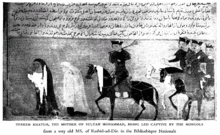Terken Khatun (wife of Ala ad-Din Tekish)
Terken Khatun, also known as Turkan Khatun (Persian: ترکان خاتون, "the Queen of the Turks"), was the Empress of the Khwarazmian Empire by marriage to Shah Ala ad-Din Tekish, and the mother and de facto co-regent of Muhammad II of the Khwarazmian Empire.[1]
| Terken Khatun | |||||
|---|---|---|---|---|---|
 Terken Khatun captive to Mongols | |||||
| Great Queen of the Khwarezmian Empire | |||||
| Reign | 1200-1220 | ||||
| Coronation | 1200 | ||||
| (co-regent) Shah of the Khwarazmian Empire | |||||
| Reign | 1200–1220 | ||||
| Coronation | 1200 | ||||
| Predecessor | Tekish | ||||
| Successor | Manguberdi | ||||
| Co-reignt | Muhammad II | ||||
| Queen of the Khwarazmian Empire | |||||
| Reign | 1172-1200 | ||||
| Coronation | 1172 | ||||
| Naib-i-Sultanat of the Khwarazmian Empire | |||||
| Reign | 1195-1220 | ||||
| Spouse | Ala ad-Din Tekish | ||||
| Issue | Muhammad II | ||||
| |||||
| House | Khwarazmian Empire (by marriage) | ||||
| Father | Kipchak Khan | ||||
| Religion | Islam | ||||
Background
Terken Khatun was from the Qanghli or the Bayads tribe of the Yemek, the daughter of the Kipchak Khan. According to Jalal ad-Din Mingburnu's biographer Muhammad Nasawai, majority of her son Ala ad-Din Muhammad's top commanders were from Terken Khatun's tribe, and the need to attach them to his side was one reason why the Shah lent so heavily on his mother for advice.[2]
De facto co-ruler and Sultan
After the death of her husband, 'Ala' al-Din Tekish (1172-1200), she so dominated the court of their son, 'Ala' al-Din Muhammad II (1200–20), and quarreled so bitterly with his heir by another wife, Jalal al-Din, that she may have contributed to the impotence of the Khwarazmian Empire in the face of the Mongol onslaught. She had a separate Diwan and separate palace and the orders of the Sultan were not considered to be effective without her signature. The Shah ruled the heterogeneous peoples without mercy. In face of Mongol attacks, Khwarazmian empire, with a combined army of 400,000, simply collapsed. Khwarazmshah Muhammed had retreated to Samarkand towards the end of his domination and he had to leave the capital city of Gurgenç (Köneürgenç, present-day Turkmenistan) to her.[3]
Mongol invasion
In 1219, Genghis Khan invaded Khwarazm. Many large and prosperous cities: Otrar, Khujand, Bukhara, Samarkand, Merv, Nishapur and others were razed and their inhabitants killed. Muhammad died after fleeing in 1220 or a year after on a deserted island in the Caspian sea. She fled with the harem and the children of Khwarazmshah, took the royal treasury, and drowned 26 hostages, sons of different conquered rulers. She passed through the Karakum and took refuge in the Ilal fortress, but the Mongols captured the fortress soon afterwards. She and all the people were captured. The sons of the Shah were killed, his women and daughters were distributed to the sons and associates of Genghis Khan.[4]
Relations with Jalal-ad-Din
Relationship between Turkan Hatun and her grandson, the son of Muhammad, Jalal ad-Din, apparently was not good. When she was told to escape from the invading Mongols, she said:
“Go away, tell him (Jalal ad-Din) to leave! How can I become dependent on the mercy of the son of Aychichek (Turkmen wife of Muhammad and mother of Jalal ad-Din) and be under his protection, when I have Uzlag-shah and Aq-shah? Even being in the captivity at the hands of Genghis Khan and my current humiliation are better for me than that!”
References
- Michal Biran (15 September 2005). The Empire of the Qara Khitai in Eurasian History: Between China and the Islamic World. Cambridge University Press. pp. 165–. ISBN 978-0-521-84226-6.
- J. A. Boyle, ed. (1968). The Cambridge History of Iran, Volume 5. Cambridge University Press. p. 191. ISBN 978-0-521-06936-6.
- http://www.guide2womenleaders.com/Iran_Heads.htm
- An-Nasawi, "Description of life of Jalal ad-Din Mingburnu". Chapter 18. Eastern Literature. http://www.vostlit.info/Texts/rus8/Nasawi/frametext2.htm
- An-Nasawi, "Description of life of Jalal ad-Din Mingburnu". Chapter 18. Eastern Literature. http://www.vostlit.info/Texts/rus8/Nasawi/frametext2.htm
- http://www.tarih-begalinka.kz/ru/timetravel/page3512/